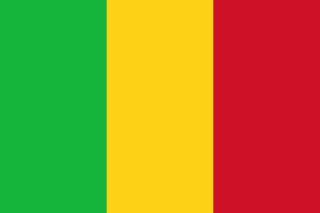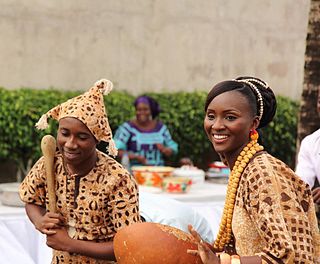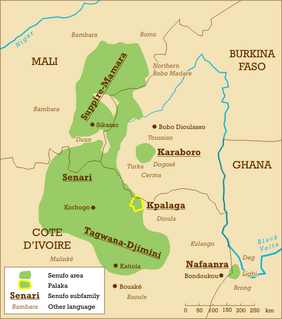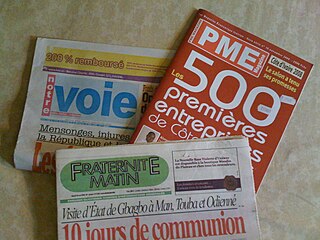| Senari | |
|---|---|
| Geographic distribution | northern Ivory Coast, southern Mali, southern Burkina Faso |
| Linguistic classification |
|
| Glottolog | cent2244 [1] |
The Senufo language area | |
The Senari languages form a central dialect cluster of the Senufo languages. They are spoken in northern Ivory Coast, southern Mali and southwest Burkina Faso by more than a million Senufo. Three varieties can be distinguished,

The Senufo or Senufic languages has around 15 languages spoken by the Senufo in the north of Ivory Coast, the south of Mali and the southwest of Burkina Faso. An isolated language, Nafaanra, is also spoken in the west of Ghana. The Senufo languages constitute their own branch of the Atlantic–Congo sub-family of the Niger–Congo languages. Garber (1987) estimates the total number of Senufos at some 1.5 million; the Ethnologue, based on various population estimates, counts 2.7 million. The Senufo languages are bounded to the west by Mande languages, to the south by Kwa languages, and to the north and east by Central Gur languages.

Ivory Coast or Côte d'Ivoire, officially the Republic of Côte d'Ivoire, is a country located on the south coast of West Africa. Ivory Coast's political capital is Yamoussoukro, while its economic capital and largest city is the port city of Abidjan. It borders Guinea and Liberia to the west, Burkina Faso and Mali to the north, Ghana to the east, and the Gulf of Guinea to the south.

Mali, officially the Republic of Mali, is a landlocked country in West Africa, a region geologically identified with the West African Craton. Mali is the eighth-largest country in Africa, with an area of just over 1,240,000 square kilometres (480,000 sq mi). The population of Mali is 18 million. Its capital is Bamako. The sovereign state of Mali consists of eight regions and its borders on the north reach deep into the middle of the Sahara Desert, while the country's southern part, where the majority of inhabitants live, features the Niger and Senegal rivers. The country's economy centers on agriculture and mining. Some of Mali's prominent natural resources include gold, being the third largest producer of gold in the African continent, and salt.
all with several dialects. With 860,000 speakers, Cebaara (Tyembara) is the largest of the four; it is also the central variety, spoken around the traditional Senufo center Korhogo. Senara (190,000 native speakers) of the Laraba Province of Burkina Faso is a geographic outlier; intelligibility testing with Cebaara yields ratings between 42 and 74 per cent (SIL). Nyarafolo is spoken by 50,000 in northeast Ivory Coast around Ferkessédougou; Ethnologue reports a classification as Tagwana-Djimini rather than Senari. Within Senufo as a whole, the Senari languages are thought to be most closely related to the Karaboro languages.

Korhogo is a city in northern Ivory Coast. It is the seat of both Savanes District and Poro Region. It is also a commune and the seat of and a sub-prefecture of Korhogo Department. In the 2014 census, the city had a population of 286,071, making it the fourth-largest city in the country and the largest in northern Ivory Coast.

Ferkessédougou is a city in northern Ivory Coast. It is a sub-prefecture of and the seat of Ferkessédougou Department. It is also the seat of Tchologo Region in Savanes District and a commune. Ferkessédougou is the second-most populous city in northern Ivory Coast, after Korhogo.

The Karaboro languages are spoken in Burkina Faso by approximately 65,000 people. They belong to the Senufo subfamily, but are separated from other Senufo languages by a small band of unrelated languages. Within Senufo they are thought to be most closely related to the Senari languages.









